Glacier National Park
Exploring America's Crown Jewel
Article Date: November, 2014
Article and Photography by Mark Quasius

Glacier National Park is one of America's crown jewels. It is located in Montana, just south of the northern border with Canada.
In fact Glacier is half of a large park system - Glacier-Waterton International Peace Park. Canada's Waterton Lakes Park begins immediately where
Glacier ends and continues north from the border. Glacier straddles the Rocky Mountains as they cross the border. It's flanked on the west side by the
Flathead Indian reservation and on the east side by the Blackfoot Reservation.
This park is unrivaled for scenic mountain views and is packed with wildlife. Its many trails take you into the backcountry
where alpine lakes abound. This park is built in mountainous terrain and the terrain ranges from gentle mountains and valleys to near vertical cliffs.
Glacier has two major areas that flank the park and serve as base camps to use when exploring this fantastic area. West Glacier
and Apgar Village are found on the west end of the park. Visitor services include helicopter flight-seeing trips, rafting trips on the Flathead River,
and various lodging, restaurant, and RV park services. In addition, the small Apgar Village is right next to West Glacier and is located right on the
shores of Lake MacDonald. On Glacier's east end is St. Mary, another area with lodging, dining, and RV services. Connecting the two is a single road
through the park called "Going to the Sun".
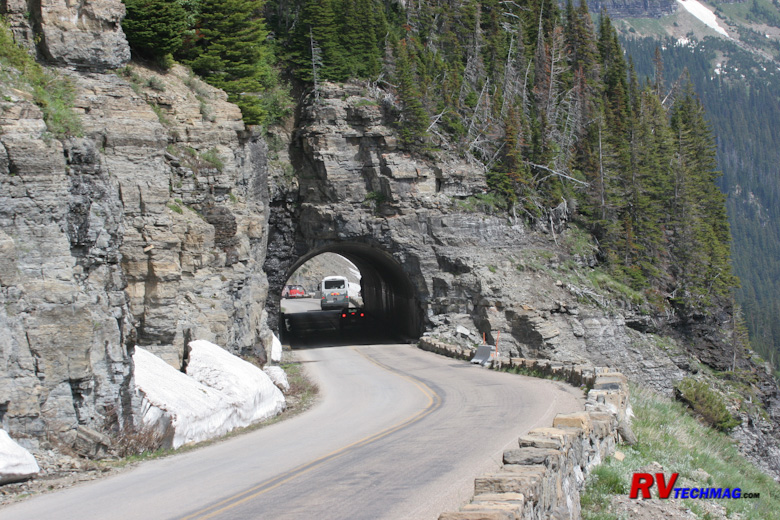
Historic Going-to-the-Sun Road clings to the side of the mountains as it traverses the park from east to west
Going to the Sun Road is an engineering marvel. Completed in 1933, it clings to the side of mountains, overlooking valleys below
and climbs to eye level with glaciers. It was designed to be architecturally invisible so as not to be a blight on the landscape. Stone masons carefully
cut and laid blocks of stone, quarried from nearby areas to create a scenic guardrail. This high alpine road generally opens in the very end of June
after all of the snow is finally cleaned away and is limited to vehicles under 21' in length due to the sharp curves. The road itself is a must-see and
one of the park's claims to fame.
But, the name of the park is Glacier and you can expect to see a number of them during your visit. Being a high country area,
there are plenty of glaciers clinging to the mountains. Many of these can be seen from Going to the Sun but there are countless others that are
accessed by numerous hiking trails. The Glaciers are receding as the global climate gradually warms every year but they are still a sight to behold.
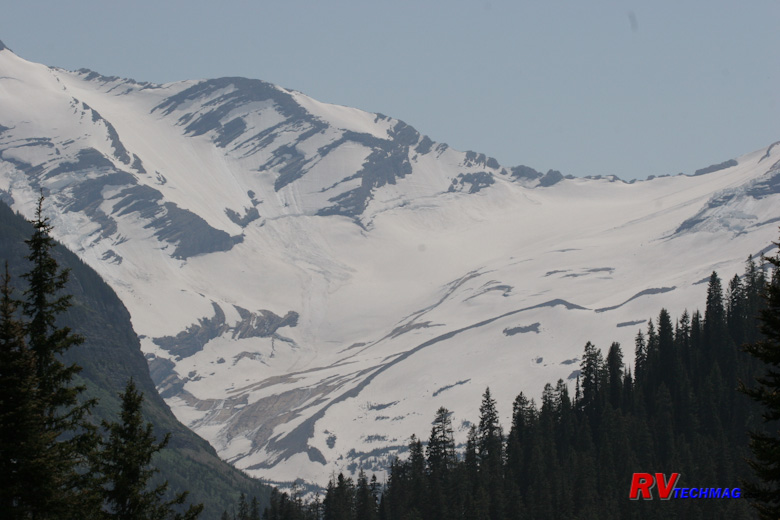
Jackson Glacier is just one of the many glaciers that can be found in the park
RV Access to Glacier
The 21' vehicle length limit on Going to the Sun road precludes taking an RV across the park. You'll need to choose your campsite
at either end and take your tow or towed vehicle to see the sites and scenery inside the park. If you need to shuttle your RV from one side to the
other you can skirt around the park's southern border on US-2. While not as spectacular as Going to the Sun, US-2 does still drive through some very
scenic areas so it's still a good option as long as you don't do it on a daily basis. There is a viewing area at Goat Lick, which is near Essex, Montana
that is capable of handling your RV. Chances are good that the mountain goats will be out nibbling on the salt in the cliffs nearby and make for an
interesting photo stop.
If your destination is the west side you can arrive from any of the four directions. US-93 southbound will bring you to Kalispell
from Canada to the north. US-2 eastbound will bring you in from Idaho's panhandle. US-93 northbound brings the majority of visitors up from interstate 90
and Yellowstone to the south. US-2 westbound will skirt around the southern edge of the park and bring you in from Browning to the east. There are a
number of full service campgrounds in West Glacier that you can select from as well as in nearby Hungry Horse, Whitefish and Kalispell. Smaller
campgrounds without hookups can be found near Apgar.
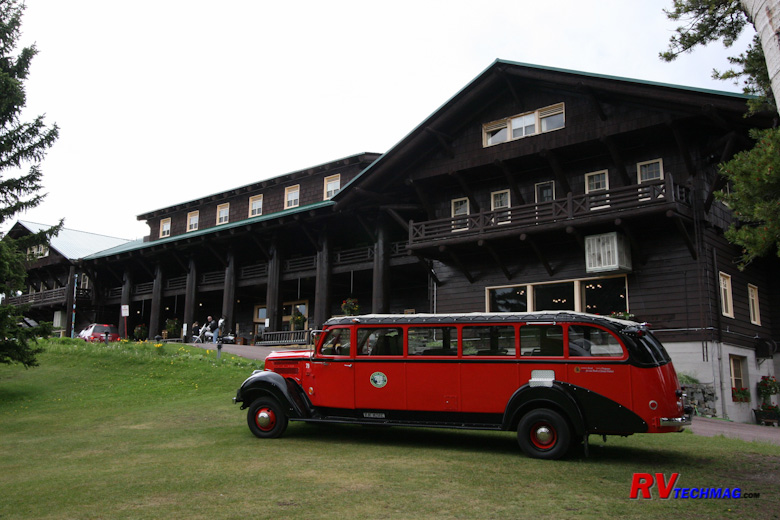
East Glacier Park Lodge was built by the Great Northern Railroad as a stop for early day travelers. Red busses, similar to the one shown in the
foreground, are available for tours for those who don't have their own vehicle
If you choose to stay on Glacier's east side then campgrounds around St Mary are the most popular. It's important to note that
highway 49 between Kiowa and East Glacier Park is a twisty climb over a mountain and RVs are prohibited on that road. If you plan on traveling with
your RV between East Glacier Park and St Mary you will need to travel to Browning and then up to St Mary rather than take the short cut.
|
US-89 is a great highway between Yellowstone and the Canadian border but the section between Browning and St Mary is a
challenge. You will be constantly be climbing over the rolling hills all the way and you'll encounter one switchback curve after the other.
It's certainly doable but not very relaxing and you will undoubtedly discover new creeks and rattles in your RV that you never found before.
A better alternative is a shortcut that we've discovered. Actually, it's a long cut in that it adds a few extra miles
to the trip but it's all smooth sailing at highway speeds and you'll arrive there in better shape than if you take the direct route over US-89.
To take this route leave US-89 in Browning and take highway 464 north. 464 is a good two lane blacktop road with gentle grades and very few curves.
Highway 464, also known as the Duck Lake road, makes a left turn and heads west past Duck Lake and meets up with US-89 just north of St Mary at
Babb.
|
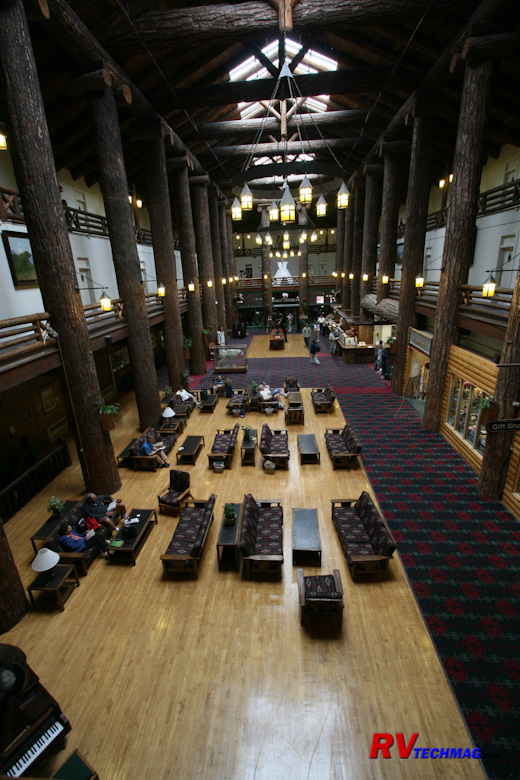
The interior lobby of East Glacier Park Lodge showcases the tall timbers that support the rustic alpine design typical to buildings
in Glacier National Park
|
|
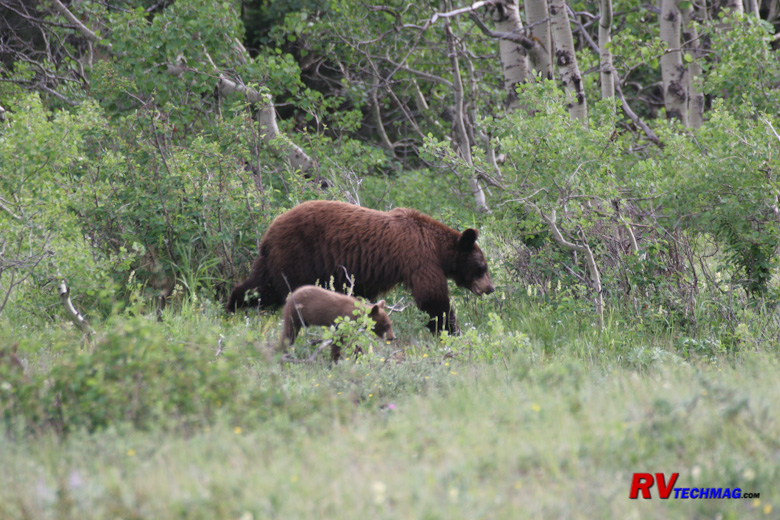
Glacier is well known for its excellent grizzly bear habitat
|
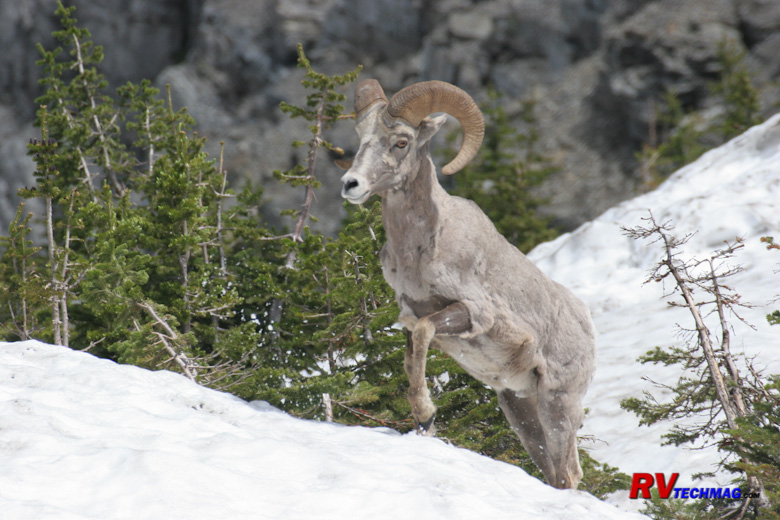
Bighorn Sheep ply the steep slopes of the high country, near Logan Pass. These sure footed animals have amazing traction and make
navigating the steep, rocky terrain look much easier than it really is
|
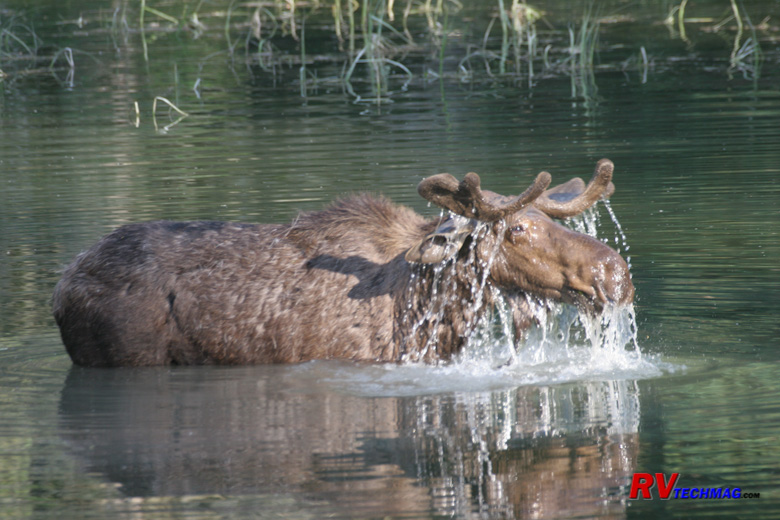
Moose browse for sedges found at the bottom of ponds and streams. During early summer the bull's antlers are covered in velvet and
are not fully grown until the fall rut in September
|
Return to Home Page
If you enjoyed this article be sure to recommend RVtechMag.com to your friends, like us on Facebook or Twitter
or subscribe to our RSS feed.



|












